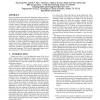Free Online Productivity Tools
i2Speak
i2Symbol
i2OCR
iTex2Img
iWeb2Print
iWeb2Shot
i2Type
iPdf2Split
iPdf2Merge
i2Bopomofo
i2Arabic
i2Style
i2Image
i2PDF
iLatex2Rtf
Sci2ools
ASPDAC
2007
ACM
2007
ACM
Hippocrates: First-Do-No-Harm Detailed Placement
Physical synthesis optimizations and engineering change orders typically change the locations of cells, resize cells or add more cells to the design after global placement. Unfortunately, those changes usually lead to wirelength increases; thus another pass of optimizations to further improve wirelength, timing and routing congestion characteristics is required. Simple wirelength-driven detailed placement techniques could be useful in this scenario. While such techniques can help to reduce wirelength, ones without careful timing constraint considerations might degrade the timing characteristics (worst negative slack, total negative slack, etc) and/or introduce more electrical violations (exceeding maximum output load constraints and maximum input slew constraints). In this paper, we propose a new detailed placement paradigm, which use a set of pin-based timing and electrical constraints in detailed placement to prevent it from degrading timing or violating electrical constraints while...
| Added | 12 Aug 2010 |
| Updated | 12 Aug 2010 |
| Type | Conference |
| Year | 2007 |
| Where | ASPDAC |
| Authors | Haoxing Ren, David Z. Pan, Charles J. Alpert, Gi-Joon Nam, Paul G. Villarrubia |
Comments (0)

